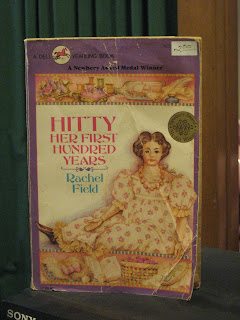
The Slave Dancer is another Newbery Award book that I hadn’t heard of before I started this project. As usual, when at a thrift store, I head to the children’s and young adult books and scan the spines for likely-looking titles or the tell-tale insignia for a Newbery book. I found this unassuming little paper back, 127 pages, and it had the gold seal of a Medal book on the upper right hand corner of the front cover. The cover had an intriguing picture of a group of huddled, bewildered-looking Africans on the deck of a ship, a boy playing a fife in their direction, and a grizzled sailor watching sternly over them.
Jessie, a boy of New Orleans, likes to play his fife down by the docks to earn a few pennies. His mother supports the family as a seamstress. When she sends Jessie out to borrow a few candles to help her work on a big project, Jessie is kidnapped, and his life changes forever. He has been taken to work as a “slave dancer” aboard a slave ship.
It was in the best interests of the slaver captain to arrive at his destination with as many healthy slaves as possible, and they felt the slaves should be “exercised.” A group of chained slaves would be made to go up on the deck and be forced to dance and move to the lilts and trills of Jessie’s fife. The boy is horrified and mortified to be doing this.
I played on against the wind and my own self-disgust, and finally the slaves began to lift their feet, the chains attached to the shackles around their ankles forming an iron dirge, below the trills of my tune. …From barely more than an audible moan or two, their voices began to gain strength until the song they were singing, or the words they were chanting, or the story they were telling overwhelmed the small sound of my playing.
Grim details are not spared just because this is a kid’s book, but they are not sensationalized either. Jessie is the narrator, observing events that make him recoil, but he is stuck on the ship and in that life—he must continue life, learning about human nature, making relationships and surviving.
The horrors of the slave trade and conditions on the slave ships are very descriptively told and moved me to compassion and to bewilderment that the tradesmen involved in it could treat other human beings in that way. It’s a story that must continue to be told. But this book is also a boy’s adventure and a journey into manhood as he deals with the crises that confront him.
I enjoyed The Slave Dancer and am glad that because of the Newbery Medal, I plucked it from the thrift store shelf of Babysitter Club and Disney books to buy it.
Jessie, a boy of New Orleans, likes to play his fife down by the docks to earn a few pennies. His mother supports the family as a seamstress. When she sends Jessie out to borrow a few candles to help her work on a big project, Jessie is kidnapped, and his life changes forever. He has been taken to work as a “slave dancer” aboard a slave ship.
It was in the best interests of the slaver captain to arrive at his destination with as many healthy slaves as possible, and they felt the slaves should be “exercised.” A group of chained slaves would be made to go up on the deck and be forced to dance and move to the lilts and trills of Jessie’s fife. The boy is horrified and mortified to be doing this.
I played on against the wind and my own self-disgust, and finally the slaves began to lift their feet, the chains attached to the shackles around their ankles forming an iron dirge, below the trills of my tune. …From barely more than an audible moan or two, their voices began to gain strength until the song they were singing, or the words they were chanting, or the story they were telling overwhelmed the small sound of my playing.
Grim details are not spared just because this is a kid’s book, but they are not sensationalized either. Jessie is the narrator, observing events that make him recoil, but he is stuck on the ship and in that life—he must continue life, learning about human nature, making relationships and surviving.
The horrors of the slave trade and conditions on the slave ships are very descriptively told and moved me to compassion and to bewilderment that the tradesmen involved in it could treat other human beings in that way. It’s a story that must continue to be told. But this book is also a boy’s adventure and a journey into manhood as he deals with the crises that confront him.
I enjoyed The Slave Dancer and am glad that because of the Newbery Medal, I plucked it from the thrift store shelf of Babysitter Club and Disney books to buy it.














